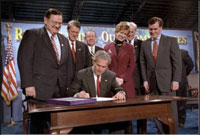Cleaner Lands
Through public-private partnerships, Federal grants and incentives, the Bush Administration has made much
progress in cleaning and restoring polluted lands. The President worked with Congress to enact historic,
bipartisan brownfields reform legislation that provides State and local governments greater abilities and
resources to turn environmental eyesores into productive community assets, creating jobs and billions of
dollars in economic revitalization in urban areas.
Reclaiming America's Brownfields
"All of us have a responsibility to be the stewards of our land. When we use the land, we must
do so wisely and responsibly, balancing the needs of the environment with the best interests of those who live
and work on the land. The law I sign today addresses the problem of land which has already been developed, and
then abandoned. American cities have many such eyesores-anywhere from 500,000 to a million brownfields are
across our nation. These areas once supported manufacturing and commerce, and now lie empty-adding nothing of
value to the community, and sometimes only causing problems. ... Environmental protection and economic growth
can go on together. It is possible for the two to exist, if we're wise about public policy. And the law that
I'm about to sign is good public policy. It's got a lot of common sense in it. It's wise. It encourages
growth. It fosters the environment. It is the best-it shows what can-it is the best of Washington, when
people decide to cooperate, not bicker, when people put the national interests ahead of political
interests."
President George W. Bush
Remarks During the Signing of The Small Business Liability Relief And Brownfields Revitalization Act
Conshohocken, Pennsylvania, January 11, 2002
 Fulfilling a campaign pledge, President Bush worked with Congress to enact historic, bipartisan brownfields
reform legislation that he signed on January 11, 2002. The Small Business Liability Relief and Brownfields
Revitalization Act gives State and local governments greater flexibility and resources to turn environmental
eyesores into productive community assets, significantly increasing the pace of brownfields cleanups.
President Bush's FY 2005 budget proposal includes $210 million for brownfields cleanup, a $40 million (24
percent) increase over the 2004 Consolidated Appropriations legislation level. The funding includes an
increase for grants and loans to fund cleanup of lightly contaminated sites. The U.S. Conference of Mayors,
the Trust for Public Land, and others have endorsed the Administration's brownfields proposal.
Fulfilling a campaign pledge, President Bush worked with Congress to enact historic, bipartisan brownfields
reform legislation that he signed on January 11, 2002. The Small Business Liability Relief and Brownfields
Revitalization Act gives State and local governments greater flexibility and resources to turn environmental
eyesores into productive community assets, significantly increasing the pace of brownfields cleanups.
President Bush's FY 2005 budget proposal includes $210 million for brownfields cleanup, a $40 million (24
percent) increase over the 2004 Consolidated Appropriations legislation level. The funding includes an
increase for grants and loans to fund cleanup of lightly contaminated sites. The U.S. Conference of Mayors,
the Trust for Public Land, and others have endorsed the Administration's brownfields proposal.
Results:
- Between 2001 and 2003, 1,176 brownfields properties were made ready for reuse, more than during the
previous seven years combined.
- Under the Bush Administration, the pace of jobs leveraged by brownfields redevelopment has increased
from about 1,400 jobs a year to almost 5,000 jobs a year. Using enhanced authority from the Brownfields
Revitalization Act of 2002, this pace of progress will increase substantially.
- In 2003, EPA provided $73.1 million for 211 competitive grants for assessment, revolving loan funds, and
cleanup in 176 localities located within 37 states and 7 tribes. In addition, EPA provided $49.7 million in
brownfields response program grants to 50 states and 30 tribes. Congress appropriated $170 million for this
work in 2004, and the 2005 budget requests $210 million.



 Fulfilling a campaign pledge, President Bush worked with Congress to enact historic, bipartisan brownfields
reform legislation that he signed on January 11, 2002. The Small Business Liability Relief and Brownfields
Revitalization Act gives State and local governments greater flexibility and resources to turn environmental
eyesores into productive community assets, significantly increasing the pace of brownfields cleanups.
President Bush's FY 2005 budget proposal includes $210 million for brownfields cleanup, a $40 million (24
percent) increase over the 2004 Consolidated Appropriations legislation level. The funding includes an
increase for grants and loans to fund cleanup of lightly contaminated sites. The U.S. Conference of Mayors,
the Trust for Public Land, and others have endorsed the Administration's brownfields proposal.
Fulfilling a campaign pledge, President Bush worked with Congress to enact historic, bipartisan brownfields
reform legislation that he signed on January 11, 2002. The Small Business Liability Relief and Brownfields
Revitalization Act gives State and local governments greater flexibility and resources to turn environmental
eyesores into productive community assets, significantly increasing the pace of brownfields cleanups.
President Bush's FY 2005 budget proposal includes $210 million for brownfields cleanup, a $40 million (24
percent) increase over the 2004 Consolidated Appropriations legislation level. The funding includes an
increase for grants and loans to fund cleanup of lightly contaminated sites. The U.S. Conference of Mayors,
the Trust for Public Land, and others have endorsed the Administration's brownfields proposal.